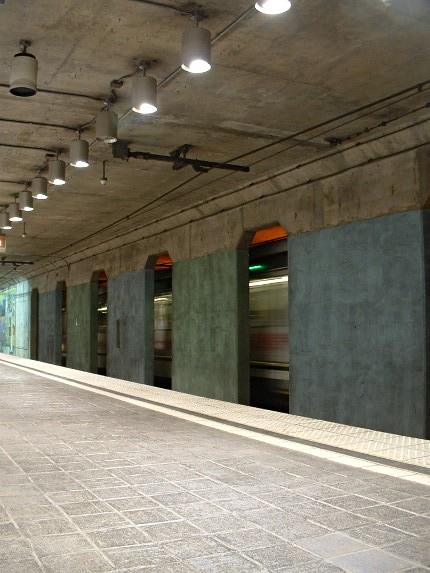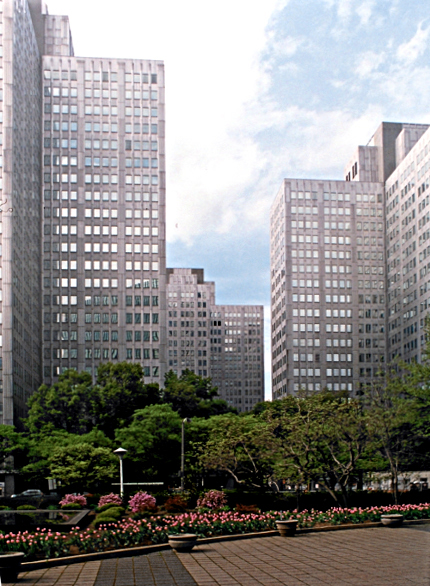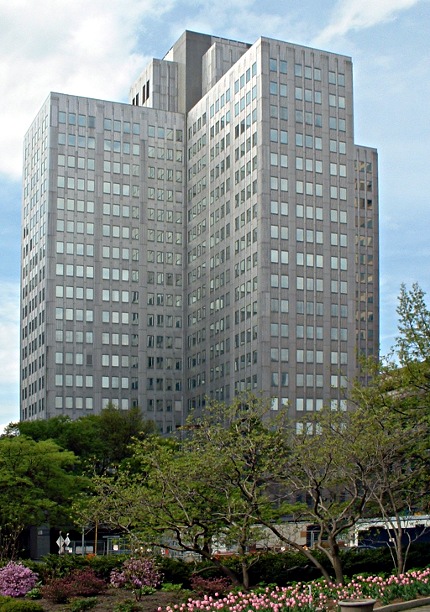
A view of One Gateway Center straight down the plaza, flanked by Two Gateway Center and Three Gateway Center.

Three Gateway Center (1952, architects Eggers & Higgins), seen down the western end of Forbes Avenue from the Diamond. The distinctive stainless-steel facing of the first three Gateway Center towers was an afterthought, and a very lucky one. They were to be faced with brick, which would have made them humdrum undistinguished vertical warehouses like a thousand other modernist cruciform brick towers around the world. But bricks were in short supply after the Second World War, and for once budget constraints led to a much more pleasing result.
The modernist ideal: towers in a park. It works here better than it works almost anywhere else it has been tried. The architects, incidentally, were the firm of Eggers & Higgins, who were the successors to John Russell Pope.
Old Pa Pitt decided to make this picture look as much as possible like an architect’s rendering. He was trying out the LightZone photo software, which will take some getting used to. For correcting lens distortion, he used the GIMP.
A kind reader who signs himself “Matt” had an excellent suggestion:
Any interest in photographing or featuring the old Gateway Center Station one last time before it closes forever this weekend?
It was never a beautiful or impressive space, but of our trio of odd underground stations, Gateway Center was the oddest. It will soon be replaced by a gleaming new station that will doubtless be more convenient and more beautiful. But old Pa Pitt confesses that he was always sneakily proud of the old Gateway Center station when he brought out-of-town visitors downtown. They might come from cities with more expensive or more comprehensive subway systems, but few subway stations are as just plain weird as Gateway Center was. Notice, for example, the low-level platform, now closed off by a rail, that was built to accommodate the old PCC cars when they still ran the Overbrook route—a feature shared by all three of the underground stations downtown.

The weirdest aspect of Gateway Center, of course, was the loop. Visitors riding the subway for the first time were always alarmed to see the station they wanted flashing by on their left, as though the car had somehow just missed it. Then came the long squealy loop that threw everybody to the right-hand side of the car, and finally the car re-emerged into the station, this time with the platform on the right side.
We’ll see more pictures of the old Gateway Center station shortly. Meanwhile, the subway ends at Wood Street until further notice, except for the next few weekends, when it ends at First Avenue.

Taken with a Zenit-B camera, which is a Soviet-era SLR, and a Vivitar 28-mm lens, which is of course not Soviet, this picture from Equitable Plaza shows Gateway Center as the perfect modernist ideal. No wonder it got so much attention.
Gateway Center is just across the street from the Gateway Center subway station.

In the late afternoon, the declining sun plays with the shining surface of Three Gateway Center. Below, this modernist fountain is one of Gateway Center’s chief attractions.


Towers in a park: the modernist architectural ideal. It almost never worked the way it was supposed to, but the massive effort poured into Gateway Center in Pittsburgh’s first “Renaissance” created a towers-in-a-park development that has actually kept its attractive shine for half a century.
The distinctive chrome coating of the three identical cruciform towers was an afterthought. According to Mr. Franklin Toker, they were designed for brick facing, but stainless steel was substituted at the last minute. Then, because the Korean war made stainless steel scarce, chrome-alloyed steel was what the builders could actually get.
Brick would have been a modernist eyesore; the gleaming chrome creates a constantly shifting landscape of light throughout the day. The other secret of the success of this development is in the landscaping: no expense was spared to make it both pleasant and useful, so that people would want to spend time outside among the towers.

It would be hard to overestimate how pernicious the effect of this beautiful and pleasant complex of towers was on the rest of the city. It was the talk of the architectural world when it went up; everyone pointed to Pittsburgh, where an ugly warehouse district had been replaced by the modernist ideal, as the future of urban planning.
People learn the wrong lessons from success. In this case, the lesson urban planners took from Gateway Center was not that attention to detail matters, and that it is vitally important to create a pleasant environment that people will love; no, the lesson they took from it was that old buildings should be replaced by blocks of towers. Ugly brick slabs went up all over the East End to warehouse the poor. Many of them have since been blown to bits by more enlightened urban planners in favor of real houses that real people like to live in, but the incalculable damage they did to their neighborhoods is only now being reversed.
Gateway Center is just across the street from the Gateway Center subway station.